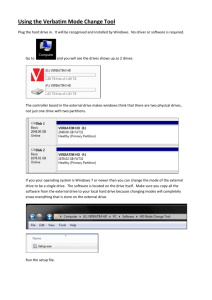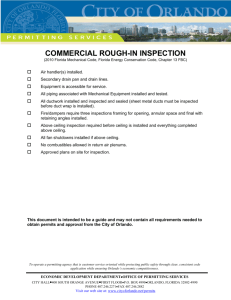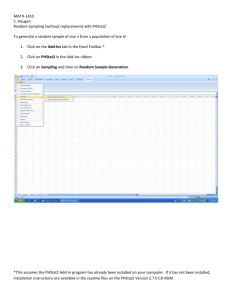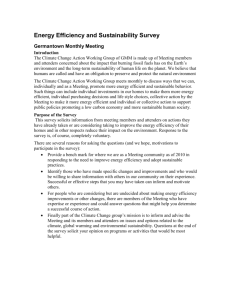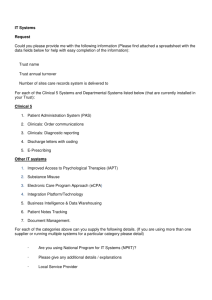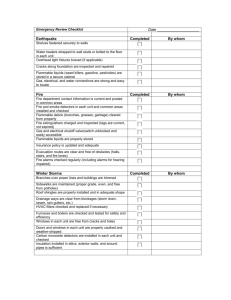docx - Vermont Business Environmental Partnership
advertisement
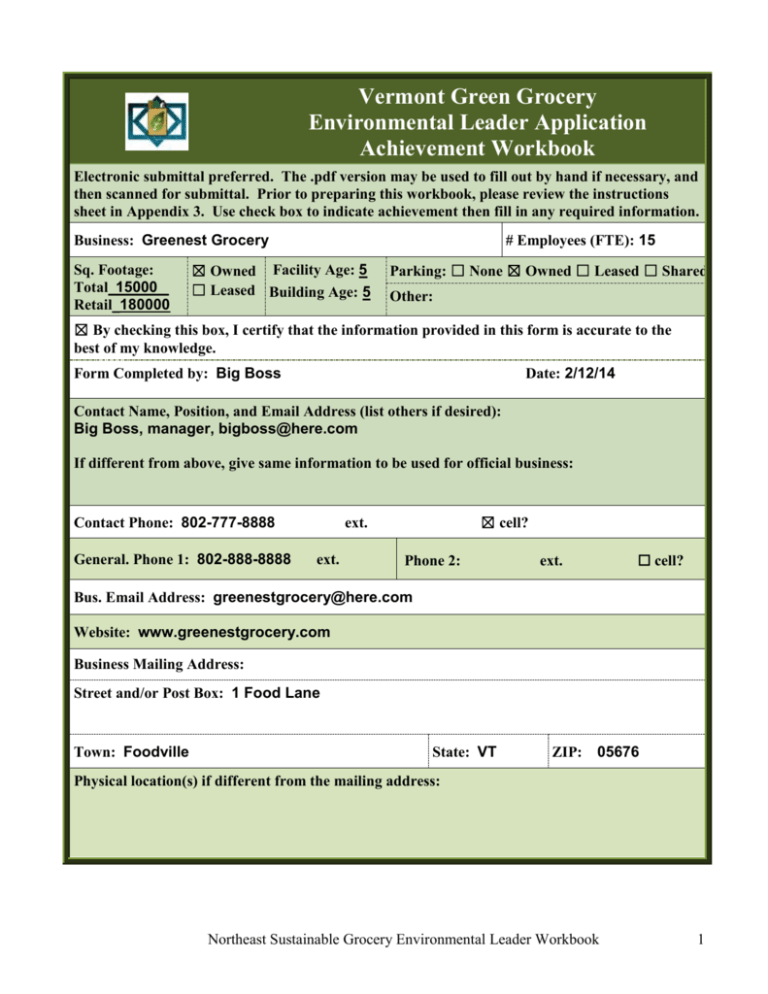
Vermont Green Grocery Environmental Leader Application Achievement Workbook Electronic submittal preferred. The .pdf version may be used to fill out by hand if necessary, and then scanned for submittal. Prior to preparing this workbook, please review the instructions sheet in Appendix 3. Use check box to indicate achievement then fill in any required information. Business: Greenest Grocery Sq. Footage: Total_15000 _ Retail_180000 # Employees (FTE): 15 ☒ Owned Facility Age: 5 ☐ Leased Building Age: 5 Parking: ☐ None ☒ Owned ☐ Leased ☐ Shared Other: ☒ By checking this box, I certify that the information provided in this form is accurate to the best of my knowledge. Form Completed by: Big Boss Date: 2/12/14 Contact Name, Position, and Email Address (list others if desired): Big Boss, manager, bigboss@here.com If different from above, give same information to be used for official business: Contact Phone: 802-777-8888 General. Phone 1: 802-888-8888 ☒ cell? ext. ext. Phone 2: ☐ cell? ext. Bus. Email Address: greenestgrocery@here.com Website: www.greenestgrocery.com Business Mailing Address: Street and/or Post Box: 1 Food Lane Town: Foodville State: VT ZIP: 05676 Physical location(s) if different from the mailing address: Northeast Sustainable Grocery Environmental Leader Workbook 1 ADMINISTRATION/OPERATIONS REQUIRED MEASURES ☒ A1. Adopted and communicated an Environmental Policy Statement. See sample language in Appendix I. Attach a copy of the written environmental policy. Describe how it is communicated to employees and customers: E-newsletter ☒ A2. ☒ A3. ☒ A4. ☒ A5. ☒ A6. Designated an Environmental Team or Representative to ensure that environmental standards are met, new initiatives are developed, and employees are trained in environmental practices. Ensure that all store employees are trained regarding their facilities environmental practices and relevant regulations. Include environmental education in new employee training. Adopted and implement an environmentally preferable purchasing policy (EPP). See sample language in Appendix I. Attach a copy of the written EPP policy. Use at least three paper products (such as post-consumer recycled or tree-free) with a minimum of 30 % post-consumer content or a minimum of 10 % tree-free fiber content , such as copy/printer, stationary/letterhead, envelopes, business forms, plates, cups, napkins, and paper towels). List: Paper towels, toilette paper, copy paper Use 3rd-party-certified green cleaners and detergents where possible, such as: all-purpose cleaners, bathroom and kitchen cleaners, glass cleaners, floor cleaners, floor strippers, and dishwasher and laundry detergent, and dish detergent. List: Use Always Green cleaners in all departments. ELECTIVES A minimum of six (6) electives for large stores (>15,000 sq. ft.) and four (4) electives for small stores (<15,000 sq. ft.) are needed for recognition. (Note: for product/equipment purchasing practices, greater than 50 % of purchases for each practice must meet the criteria specified.) Percentages for post-consumer (PC) content are from EPA procurement guidelines - http://www.epa.gov/epawaste/conserve/tools/cpg/products/ Administrative ☐ A7. Use computers and displays certified by the Electronic Product Environmental Assessment Tool (EPEAT)- . For information on EPEAT certified products, visit: http://www.epeat.net. List brands & models: ☒ A8. Installed recycled-content parking stops (curbs), picnic tables, benches, chairs, bike racks, and/or other outdoor items. (≥ 90 % PC plastic, ≥ 25% PC aluminum, ≥ 16% PC steel or other recovered materials). Describe: Parking stops are > 90% PC plastic ☒ A9. Use recycled-content trash bags in-house that are ≥10 % PC content or certified compostable bioplastic. Northeast Sustainable Grocery Environmental Leader Workbook 2 ☐ A10. Use recycled content trash/recycling receptacles with the PC minimum content indicated: steel ≥16 %; aluminum > 25%, plastic ≥ 20 %; corrugated paper ≥ 25 %; solid fiber paper boxes ≥ 40 %; industrial paperboard ≥ 40 %. List types with PC content: ☐ A11. Procure print jobs using coated paper that contain a minimum of 10 % PC, uncoated paper with a minimum of 30 % PC, or a minimum of 10 % tree-free fiber content. Describe: ☒ A12. Use any paper product that is unbleached or bleached with an alternative to chlorine. Describe: Green Gals unbleached paper napkins. ☒ A13. Use any paper products made from 80-100 % post-consumer content. List types and brands: 80% PC recycled toilet paper, Green Gals Operations ☒ A14. Use environmentally friendly garment cleaning services, such as chlorine-free laundering for linens, wet cleaning in place of perc dry cleaning for uniforms, or use similar methods for inhouse cleaning. Describe: Wet cleaning for aprons and wipe clothes. ☐ A15. Implement a written procedure that minimizes the use of sanitizers and disinfectants. The procedure must include use of personal protective equipment as required per the label or safety data sheets. Available upon request. (Ask for a sample procedure.) ☒ A16. Notify the public of pesticide application(s) at the site. ☒ A17. Use environmentally preferable pest control products or/and third party green certified pest control companies for maintenance and landscaping, whenever needed. Describe (include company and certifier, if applicable): Green Gals bug killers, EnviroGood certified. ☐ A18. Use Integrated Pest Management in-house or through contract. Describe (include company and certifier, if applicable): ☐ A19. Use only pesticides listed as allowed on the National Organic Program's List of Allowed Substances, where effective and feasible. For a partial list see: http://www.naturallygrown.org/resources/allowedprohibited. Describe Northeast Sustainable Grocery Environmental Leader Workbook 3 ☐ A20. Used at least two environmentally preferable building materials for construction or renovation projects, such as low- or no-VOC paint, recycled or FSC wood, recycled plastic lumber, or glass asphalt. Describe material or product (include brand and use): ☐ A21. Have an inspection and maintenance procedure for parking lot and stormwater management that includes proper labeling of storm drains. Available upon request. ☒ A22. Minimize stormwater impacts through the use of natural materials. For example, compost, mulch, vegetative buffers using native vegetation, and rain gardens. Describe: Rain garden at base of parking lot run-off ☐ A23. Installed permeable pavement. Describe: ☒ A24. Implement an anti-idling policy for deliveries and/or parking with appropriate notification and signage. ☐ A25. Utilized 'coal tar-free' sealants on pavement. For information, visit: http://water.usgs.gov/nawqa/asphalt_sealers.html. ☒ A26. Use environmentally preferable products for melting ice on walkways and parking lots. http://www.phillywatersheds.org/whats_in_it_for_you/residents/winter-ice-removal. Describe material or product: Calcium magnesium acetate ☐ A27. Use stormwater best management practices to minimize watering, erosion, and indirect water pollution. Best practices may be included in required federal Storm Water Pollution Prevention plans, where applicable. For examples of best practices, visit http://www.flowstobay.org/bs_food_facilities.php, or http://www.cleanwaterprogram.org/business/best-practices/item/best-practices.html. For an example of a Stormwater Pollution Prevention Plan for a supermarket or grocery store, visit: http://newrochelleny.com/DocumentCenter/Home/View/202. Describe: Other ☐ A28. Describe: Northeast Sustainable Grocery Environmental Leader Workbook 4 WASTE REDUCTION REQUIRED MEASURES ☒ B1. Designate a waste reduction/recycling coordinator. Contact Name: Little Boss ☒ B2. Completed an internal waste audit within the last five years. Not applicable. Reason: ☒ ☐ B3. Manage hazardous waste, electronics waste, and universal waste in accordance with federal, state, and local laws. Electronics waste includes items such as computers, computer monitors and peripherals, printers, scanners, and TVs of any type. Universal waste includes items such as fluorescent lamps and bulbs and mercury thermostats. B4. Properly dispose of unused or expired pharmaceuticals or return them to the manufacturer. Not applicable. Reason: Not sold ☒ B5. Minimize paper use by double-sided printing and delisting from junk mail. ☒ B6. Train and oversee staff to prevent food waste from food preparation, produce, meat, and deli ☐ departments. See http://www.epa.gov/foodrecovery/fd-reduce.htm for ideas. B7. Participate in food recovery through the state's food bank or other organizations. Not applicable. Reason: No local organization. ☒ B8. Maintain a comprehensive recycling program for all glass, paper, cardboard, metal, and plastic, which includes good signage, convenient containers for collection, continual staff training, and feedback for waste prevention, reuse, and recycling. List materials: Plastic and glass containers, aluminum and metal cans ☒ B9. Recycle electronics, batteries, printer cartridges, and other hard to recycle items. List: ☐ B10. Collect cooking oil for recycling or for biodiesel. Not applicable. Reason: Not used ☒ B11. Collect food and other organic waste for animal feed or composting, where outlets are available. Check all that apply. ☒ Produce ☒ Meat ☒ Bakery ☒ Dairy ☒ Plant ☐ Other: Not applicable. Reason: Northeast Sustainable Grocery Environmental Leader Workbook 5 ELECTIVES A minimum of seven (7) electives for large stores (>15,000 sq. ft.) and five (5) electives for small stores (<15,000 sq. ft.) are needed for recognition. Check all that apply. General ☒ B12. Track waste prevention, reuse, and recycling. Available upon request. ☐ B13. Establish a zero waste policy and practice that achieves at least a 90% solid waste diverted from landfill through reduction, reuse, recycling, and composting. Attach a copy of the policy. ☒ B14. Donate, give-away, sell, or exchange usable items (e.g., furniture, supplies, packaging, and electronics) or use a waste exchange program such as www.reusemarketplace.org. Describe: Reduce ☐ B15. Use only compostable paper, and bio-based plastics or recyclable plastics for take-out food containers or eliminate the use of foamed polystyrene (e.g., Styrofoam™) packaging. ☐ B16. Require vendors to take back single-use packaging, such as pastry boxes. ☒ B17. Specify that vendors use transport packaging that is reusable, recyclable or compostable. ☐ B18. Work with vendors to minimize transport and product packaging. ☐ B19. Installed hand dryers (< 1500 watts) instead of paper towels in bathrooms. ☒ B20. Use permanent-ware mugs or cups for employee drinks. ☐ B21. Use refillable condiment dispensers instead of individual packets in the dining areas. ☒ B22. Use reusable metal or nylon coffee filters, and/or compost paper ones. ☐ B23. Serve unwrapped straws from a dispenser. ☒ B24. Minimize the volume of to-go or in-house food packaging. ☐ B25. Serve beverages from a beverage gun or dispenser. Buy milk in 5-gallon dispenser boxes. ☐ B26. Offer customers a discount if they bring their own mugs, containers, or bags for take-out. ☐ B27. Offer incentives to customers to bring containers for bulk food. ☒ B28. Offer incentives to customers to being their own shopping bags. Reuse ☐ B29. Encourage the reuse of at least three types of containers and packaging by working with suppliers to take it back or by donating it locally. Examples of containers and packaging include pallets, corrugated cardboard boxes, packing peanuts, and/or buckets. ☒ B30. Return waxed cardboard containers to vendor or compost. ☐ B31. Practice in-house reuse of at least three different packing materials/containers. Examples of containers and packaging include cardboard boxes, bubble wrap, plastic, and bags. List types: ☐ B32. Use rechargeable batteries. Northeast Sustainable Grocery Environmental Leader Workbook 6 Recycle ☒ B33. Provide recycling for consumer shopping bags. ☐ B34. Recycle or provide consumer recycling for other harder-to-recycle materials (e.g. packaging like shrink wrap and plastic film, batteries, gable-top refrigerator cartons, or aseptic packaging) Describe: ☐ B35. Collect animal parts for rendering. Other ☐ B36. Describe: REQUIRED MEASURES ☒ C1. Completed a comprehensive energy efficiency assessment in the last 3 years. Year: 2014 Performed by: Efficiency Vermont Not applicable. Reason: ☒ ☒ ☒ C2. Have a written procedure for unoccupied building mode (building shut down). See sample language in Appendix 3. Available upon request. C3. Maintain an HVAC preventative maintenance schedule and procedures that include changing filters at prescribed intervals and keeping air discharge grills clear. Not applicable. Reason: C4. Installed weatherization, such as weather stripping, foam, and window covers, or air conditioner covers throughout the building to reduce air infiltration. Not applicable. Reason: ☒ C5. Maintain programmable thermostats with 10+ ⁰F setbacks when building is unoccupied and have thermostats set to optimum temperatures when occupied - 68°F in the winter and 78°F in the summer. Not applicable. Reason: ☒ C6. Replaced all T12 and incandescent indoor lighting with T8/T5, CFL, LED, or other energy efficient lighting. Not applicable. Reason: ☒ C7. Check seals on cooler/freezer doors annually and replace as needed. ☒ C8. Installed energy efficient lighting such as fluorescent, cold cathode, or LED in walk-in or reach- in coolers. Northeast Sustainable Grocery Environmental Leader Workbook 7 ELECTIVES A minimum of ten (10) electives are needed for recognition or have followed all the feasible recommendations of a current energy audit. Check all that apply. General ☐ C9. Completed EPA’s ENERGY STAR Portfolio Manager. To access Portfolio Manager, visit http://www.energystar.gov/index.cfm?c=grocery.sb_grocery. ☐ C10. Installed on-demand hot water heaters. ☒ C11. Insulated all hot water pipes. ☒ C12. Use timers on coffee makers, hot/cold water fountains, and other appliances so water is not heated or cooled when not in use. ☒ C13. All exit signs are LED or electroluminescent alternatives without tritium or other radioactive substances. ☐ C14. Installed thermapane or low E windows (including low E films) on more than 75 % of the building. ☒ C15. Installed any of the following high efficiency, ENERGY STAR appliances or equipment in the last five years.(http://www.energystar.gov/index.cfm?c=bulk_purchasing.bus_purchasing&s=m) ☐ clothes washer ☒ refrigerator(s) ☐ water cooler(s) ☐ computer monitor(s) ☐ dishwasher(s) ☐ ice maker(s) ☐ fryer(s) Other (e.g. microwave): List brands & models: ☐ ☐ ☐ ☐ ☒ printer(s) Refrigeration C16. Recommission refrigeration units every two years. For information on recommissioning visit http://www.energystar.gov/ia/business/EPA_BUM_CH11_Supermarkets.pdf?742a-fcd6 C17. Installed new energy efficient refrigeration units or retrofit with Year installed: Electronically Commutated Motors (ECMs) for fans. See http://www2.epa.gov/sites/production/files/documents/retrofit_guidel ine_august_2011.pdf. C18. Installed economizers on walk-in coolers and freezers. Year installed: C19. Installed energy efficient compressors, such as discus or scroll. Year installed: ☐ C20. Installed pressure controls, such as floating head and liquid pressure amplifiers. ☐ C21. Installed variable speed/frequency drives on motors. Year installed: ☐ C22. Installed zero energy case doors. ☒ C23. Installed humidity based (anti-sweat) door/frame heater controls. Year installed: Year installed: ☒ C24. Use high temperature alarms. ☒ C25. Installed strip curtains on walk-in units and refrigerated warehouses. ☒ C26. Use night covers for all open refrigeration units. ☐ C27. Installed vending machine controls such as "Misers". Lighting ☒ C28. Use lighting controls, such as timers, occupancy sensors, daylight sensors, and dimmers on indoor lighting. ☐ C29. Use lighting controls, such as daylight sensors and motion controls on outdoor lighting. Northeast Sustainable Grocery Environmental Leader Workbook 8 ☐ C30. Installed energy efficient outdoor lighting, such as CFLs and LEDs on the building/s and walkways. ☒ C31. Disconnect ballast in fluorescent fixtures that are not currently in use and replace burned out or flickering lamps to avoid ballast damage. ☐ C32. Installed LEDs in more than 50 % of interior lighting. ☐ C33. Installed LEDs in more than 50 % of refrigeration lighting. ☐ C34. Upgraded all parking lot lighting to LED. HVAC ☐ C35. Completed a heating system upgrade on existing buildings. Efficiency (AFUE, IEEC) % Year installed: ☐ C36. Completed a cooling system upgrade on existing buildings. Efficiency (EEC, SEEC, IEEC, or HSPF): Year installed: ☐ C37. Recommission or retrocommission HVAC system every two years. To learn more visit: http://www.energystar.gov/ia/business/EPA_BUM_CH5_RetroComm.pdf?ce5a-b98d. Year installed: 2013 ☒ C38. Installed high efficiency air conditioning units, such as ENERGY STAR-certified units. ☐ C39. Installed low pressure-drop air filters. ☐ C40. Installed exhaust heat recovery. Year installed: Year installed: Year installed: ☐ C41. Installed refrigeration heat recovery. ☐ C42. Installed demand controlled variable speed/frequency HVAC ventilation motors. Describe including year installed: ☒ C43. Installed demand-controlled variable speed/frequency kitchen ventilation (hood vent motor). ☐ C44. Installed A/C economizers. Year Installed: 2012 Year installed ☐ C45. Installed HVAC output control, bypass timers, and/or time clocks. ☐ C46. Installed infrared heating in loading bays or garages. Year installed: ☐ C47. Installed strip curtains on heated loading dock bays. ☐ C48. Installed evaporative cooling. Year installed: Year installed: Year installed: ☐ C49. Building has a dehumidification system. ☒ C50. Insulated heating and/or central air conditioning ducts/pipes. ☐ C51. Insulated building to meet or exceed code. Alternately had measured comprehensive air sealing by a blower door test or equivalent with result meeting code. ☐ C52. Zoned butcher area separately. ☐ C53. Use ceiling fans in spaces with high ceilings. Other ☐ C54. Describe: Northeast Sustainable Grocery Environmental Leader Workbook 9 WATER CONSERVATION REQUIRED MEASURES ☐ D1. Check at least monthly for any water leaks and repair if found. ☐ ☐ ☐ ☐ ☐ ☐ ☐ D2. Installed high efficiency pre-rinse spray valve(s) in kitchens (≤1.28 gpm). For more information, visit: http://www.epa.gov/watersense/commercial/docs/watersense_at_work/#/130/. Not applicable. Reason: D3. Installed ≤2.2 gpm faucets or aerators on all non-pot filling kitchen faucets. Not applicable. Reason: D4. Installed ≤1.5 gpm faucets or aerators on all restroom sinks. See comment. Not applicable. Reason: D5. Installed low-flow toilets (≤1.6 gallon). Not applicable. Reason: ELECTIVES A minimum of 2 (two) electives are needed for recognition. Check all that apply. Operations/ Maintenance D6. Conducted a comprehensive water audit within the last three years. Year: Performed by: D7. Adopted and employs a water conservation procedure. Attach a copy of the written water conservation procedure. A sample procedure is available upon request. D8. Installed WaterSense-certified fixtures not listed elsewhere. List: Restroom/Kitchen D9. Installed ≤1.5 gpm faucets or aerators on non-potfilling kitchen sinks. ☐ D10. Installed ≤0.5 gpm faucets or aerators on all hand washing sinks. ☐ D11. Installed high efficiency pre-rinse spray valve(s) in kitchens (≤0.8 gpm). For more information, visit: http://www.epa.gov/watersense/commercial/docs/watersense_at_work/#/130/. ☐ D12. Installed high efficiency toilets (≤1.28 gpf). ☐ D13. Installed dual flush toilets (effective flush volume ≤1.28 gallons). ☐ D14. Installed urinals that are waterless or high-efficiency (≤0.5 gpf). List: ☐ D15. Installed automatic on/off faucets in hand washing sinks in restrooms and food prep areas. ☐ D16. Installed foot pedal controls on kitchen faucets. Landscaping ☐ D17. Use smart irrigation controls or schedule watering to minimize evaporation and overall water use. ☐ D18. Practice low maintenance, water efficient landscaping like Xeriscaping that reduces or eliminates the need for watering and irrigation. Northeast Sustainable Grocery Environmental Leader Workbook 10 ☐ D19. Capture rainwater for reuse using cisterns. ☐ D20. Capture rainwater for reuse using rain barrels and irrigation bags. Other ☐ D21. Describe: RETAIL ELECTIVES A minimum of eight (8) electives are needed for recognition. Check all that apply. There are no required practices in the Retail section. Examples of third-party certifiers for environmentally preferable products include Green Seal (www.greenseal.org), EcoLogo (http://www.ecologo.org/en/certifiedgreenproducts/), and DfE (http://www.epa.gov/dfe/pubs/projects/formulat/formpart.htm), For others see http://www.environmentla.org/pdf/2011/ECO_Logos.pdf Environmental Preferred Purchasing Products ☐ E1. Recycled Post-Consumer (PC) Content Paper Products, at least three, examples include copy paper ≥30 percent, toilet tissue ≥ 20 percent, paper towels ≥ 40 percent, napkins ≥ 30 percent, facial tissues ≥ 10percent, envelopes ≥ 30 percent, and all other papers ≥30 percent. List: ☐ E2. Reusable Shopping Bags (Non-Paper). ☐ E3. Third-Party Certified Green Cleaning Products, at least three. Examples of third-party certifiers include Green Seal, EcoLogo, and DfE. List: ☐ E4. Organic-Certified Non-Food Products, at least three, such as personal care products or clothing). List: ☐ E5. Locally-Produced Non-Food Products, at least three, such as personal care products, pet supplies, crafts, office supplies, or home decorations). List: ☐ E6. Compostable Dinnerware and Cutlery, at least three types: Plates: ☐ Large ☐ Medium ☐ Small ☐ Bowls Cups: ☐ Hot ☐ Cold ☐ Cutlery ☐ Other: Northeast Sustainable Grocery Environmental Leader Workbook 11 ☐ E7. Pesticide Listed As Allowed On The National Organic Programs 'List Of Allowed And Prohibited Substances', at least one. For partial list see: http://www.naturallygrown.org/resources/allowedprohibited List: ☐ E8. USDA-Certified Bio-Preferred, (Non-Food) Products, at least one. List: ☐ E9. Recycled PC Content Non-Paper Products. ☐ Plastic cups ☐ Plastic food bags ☐ Plastic trash bags ☐ Trash receptacles ☐ Crafts and craft supplies ☐ Home decorations ☐ Pet supplies ☐ Office supplies (non-paper) ☐ Other: ☐ E10. Forest Stewardship Council (FSC)-Certified Paper Products (https://us.fsc.org/): at least two. List: Sustainable Food Sourcing Purchased Within 200 miles: Check all. ‘Baked goods must have majority of ingredients purchased within 200 miles’ or the original ‘from local bakery supplies’. Product List types (one product required per category) ☐ E11. Deli ☐ E12. Meat ☐ E13. Produce ☐ E14. Eggs ☐ E15. Dairy ☐ E16. Baked Goods ☐ E17. Dry Goods ☐ E18. Other Northeast Sustainable Grocery Environmental Leader Workbook 12 Sourced Certified Organic: Check all. Product List types and certification (one product required per category) ☐ E19. Deli ☐ E20. Meat ☐ E21. Produce ☐ E22. Eggs ☐ E23. Dairy ☐ E24. Baked Goods ☐ E25. Dry Goods ☐ E26. Other ☐ E27. Seafood And Shellfish that is 3rd Party Certified As Sustainably Harvested Or Raised Using Best Aquaculture Practices, such as those certified by the Marine Stewardship Council (www.msc.org) and the Best Aquaculture Management Practices (www.aquaculturecertification.org). List, with certification: ☐ E28. Seafood And Shellfish that is Responsibly Harvested From Northeast Waters, such as those carrying the Gulf of Maine Sustainably Harvested™ brand. For information, visit: http://www.gmri.org/community/display.asp?a=5&b=25&c=189. List: Northeast Sustainable Grocery Environmental Leader Workbook 13 STEWARDSHIP ELECTIVES A minimum of three (3) electives are needed for recognition. Check all that apply. There are no required practices in the Stewardship section. Customers & Community ☐ F1. Collaborate with community on an environmental project at least annually. Describe: ☐ F2. Practice habitat protection, on- or off-site, such as an Audubon Butterfly Sanctuary Program. Describe: ☐ F3. Inform customers on website or in-house about environmental initiatives. Provide link or describe: ☐ F4. Inform customers on website or in-house about local foods sold. Provide link or describe: ☐ ☐ ☐ ☐ ☐ ☐ Policy/ Administration F5. Completed a carbon footprint assessment. Date: By whom: F6. Participate in EPA’s GreenChill program to manage refrigeration chemicals. For information on GreenChill, visit: http://www2.epa.gov/greenchill. F7. Participate in EPA's Green Power Partnership. For information on the Green Power Partnership, visit: http://www.epa.gov/greenpower/ F8. Participate in EPA's SmartWay program. For information on the SmartWay program, visit: http://www.epa.gov/smartway/. F9. Received Leadership in Energy & Environment Design (LEED) certification for new or existing buildings. F10. Received ENERGY STAR certification for new or existing buildings. ☐ F11. Provide employee and/or customer incentivizes to utilize alternative transportation such as providing a bike rack, offering car pool incentives, and offering public transit incentives. ☐ F12. Provide opportunities for ongoing environmental education for employees. Describe: Northeast Sustainable Grocery Environmental Leader Workbook 14 Facilities ☐ F13. Used non-ozone depleting refrigerants. Describe: ☐ F14. Purchased carbon offsets. Describe: ☐ F15. Purchased renewable energy # of kilowatt hours: % of KWH: Type of purchase such as renewable energy credits, green tags, direct purchase): ☐ F16. Installed clean and renewable energy generation, such as wind turbines or solar panels. Describe: ☐ F17. Installed solar hot water system. Describe: ☐ F18. Retrofitted to natural gas in place of oil. Describe: ☐ F19. Use biofuels for space heating or biodiesel vehicles. Describe: ☐ F20. Installed a 'Green Roof'. Describe: Other ☐ F21. Describe: Northeast Sustainable Grocery Environmental Leader Workbook 15 Vermont Business Environmental Partnership NORTHEAST SUSTAINABLE GROCERY ENVIRONMENTAL LEADER AGREEMENT We understand that to be a NORTHEAST SUSTAINABLE GROCERY ENVIRONMENTAL LEADER, the business has met and will continue to meet the program standards. 1. The Sustainable Grocery Workbook has been completed and is attached, or has been previously submitted to the DEC’s Environmental Assistance Office, signifying that the standards have been satisfied. 2. Continual improvement is an important part of being an environmental leader. We will be pursuing the following one or two next steps in the coming year. 3. Our business is in good regulatory standing with all Federal, Vermont, or local environmental regulations. 4. In addition, we agree to: a. ensure that the standards for the program as documented continue to be met and, as feasible, improved upon; b. complete and return the Annual VBEP Survey which is necessary for continued designation in the program; c. continue to make a good faith effort to comply with all local, state and federal environmental regulations; d. notify the program representative of a change in our situation, if unable to meet program standards; and e. promote the Vermont Business Environmental Partnership by putting the logo with a link on our website and/or using the logo in other publicity. For electronic submittal, check the box. ☐ I understand that checking this box is equivalent to my signature and indicates my agreement with the above. (Enter name and date in line below signature line.) ☐ I am willing to have my contact information provided to others to assist them in their leadership efforts. or Signature, if handwritten. Print or Type (Owner, Manager, or other Authorized Representative) Date Please submit the completed agreement to your program representative. Peter Crawford Environmental & Regulatory Assistance Vermont Small Business Development Center P.O. Box 188 Randolph Center, VT 05061 pcrawford@vtsbdc.org 802-728-1423 Vicky Viens VT DEC EAO 1 National Life Drive, Davis 1 Montpelier, VT 05620-3704 vicky.viens@state.vt.us 802-828-1137 Northeast Sustainable Grocery Environmental Leader Workbook 16 VBEP NORTHEAST SUSTAINABLE GROCERY ENVIRONMENTAL LEADER APPENDIX I: INSTRUCTIONS This workbook is only for those applying for the Northeast Sustainable Grocery Environmental Leader program. Other programs have their own Achievement Workbooks. Electronic submissions are greatly preferred. Complete this workbook to document how your business achieves program standards. Please estimate quantities when previous measurements are not available or are too difficult to obtain. Remember to include the units of measure (examples of units are lbs., reams, 8 oz. bottles, rolls, volumes, etc.). Estimating quantities helps to get you thinking about how the initiative might be measured to track your achievements. If the Workbook is emailed and you can receive in ‘HTML mode’, the check boxes should work. If they don’t, just click on the box and put in an X or checkmark. Businesses must be performing all “REQUIRED MEASURES” and the minimum number of “ELECTIVES” in each section to qualify. . The main body of the workbook, despite its appearance, is one table. As you fill in descriptions and lists, if you go beyond the space provided, the cells and table will expand. The appearance of the table is from judicious use of Paragraph Controls: ‘Keep together’ & ‘Keep with next’. They may cause strange breaks if the table changes in size. This is not problem. Ignore it or fix the Paragraph Controls. For each measure checked, all information requested must be provided. If it is not, the measure will be disqualified for acceptance. Descriptions should be succinct and need not be complete sentences with just enough information for the reviewer to approve the measure. Please indicate all the measures that you do to give the review a complete picture of your business. As part of the program requirements, your business needs to complete an annual survey. This requires your business put in a reasonable effort to measure or accurately estimate quantities for boxes checked in the Achievement workbook that requests quantity. An example of accurately estimating would be to measure compostables collected for a typical day and multiply by the number of days of collection for a year. The program representatives can provide ideas for what should be done by your size business to track its VBEP efforts. Contact a program representative if you have not had the required on-site assessment. There is no cost to participate in this program, including the site visit. See www.vbep.org for more information about the program. VBEP Representatives: Peter Crawford Environmental & Regulatory Assistance Vermont Small Business Development Center P.O. Box 188 Randolph Center, VT 05061 pcrawford@vtsbdc.org 802-728-1423 Vicky Viens VT DEC EAO 1 National Life Drive, Davis 1 Montpelier, VT 05620-3704 vicky.viens@state.vt.us 802-828-1137 Northeast Sustainable Grocery Environmental Leader Workbook 19 APPENDIX 2: SAMPLE POLICIES ENVIRONMENTAL POLICY/MISSION STATEMENT: Sample "(Business) is committed to protecting the environment, the health and safety of our employees, and the community in which we conduct our business. It is our policy to seek improvements throughout our operations to lessen our impact on the local and global environment by conserving energy, water, and other natural resources; reducing waste generation; recycling and purchasing recycled products; and reducing our use of toxic materials. We are committed to pollution prevention, continuous improvement and meeting or exceeding all environmental regulatory requirements." ENVIRONMENTALLY PREFERABLE PRODUCTS (EPP) PURCHASING POLICY Sample 1 Preference will be given to purchasing products and services that have the following environmentally friendly attributes with acceptable parameters for price, quality, and delivery: maximum post-consumer recycled content, minimum packaging and other wastes, minimum toxicity, are durable and reusable, are locally available to minimize transportation, made from sustainably produced materials, are compostable or biodegradable, and conserve energy, water, and other natural resources. Sample 2 The goal of this policy is to ensure that products and services purchased or contracted for conform to the goals of our company's environmental policy. We will strive, where feasible, to purchase environmentally preferable products and services to meet the company's office and operational needs. We will also favor suppliers who strive to improve their environmental performance, provide environmentally preferable products, and who can document the supply-chain impacts of their efforts. Wherever possible, purchasing decisions will favor products and feedstocks that reduce greenhouse gas emissions, are made with renewable energy, reduce pollution from all discharges (releases to air, water, and land), reduce the use of toxic materials hazardous to the environment, employees, and public health, contain the highest possible percentage of post-consumer recycled content, followed by percentage of recycled content, reduce packaging and other waste, are energy efficient, conserve water, are reusable and/or durable, minimize transportation (local sources, more concentrated products), and serve several functions (for example, copier/printers, multipurpose cleaners) to reduce the overall number of products purchased. Environmentally preferable products and services that are comparable in quality to their standard counterparts will receive a purchasing preference. In situations where the most environmentally preferable product is unavailable or impractical, secondary considerations will include production methods and the environmentally and socially responsible management practices of suppliers and producers. Environmentally preferable purchasing is part of our long-term commitment to the environment. By sending a clear signal to producers and suppliers about this commitment, we hope to support wider adoption of environmentally preferable products and practices. Northeast Sustainable Grocery Environmental Leader Workbook 1 APPENDIX 3: SAMPLE UNOCCUPIED BUILDING (SHUT DOWN) PROCEDURE 1. The manager is responsible for ensuring that building shut down is completed each night. If she/he has to leave before closing, she/he will assign another staff to this task. 2. All nonessential lights are turned off. Lights to be left on for safety are: 3. All nonessential equipment, cash registers, computers and electronic devices are shut down and power turned off. DO NOT TURN OFF COMPUTER SERVERS. Other than refrigeration units, equipment needed to be left on are: 4. Heat is lowered to 60 degrees during the night. 5. Freezers/coolers are checked to ensure they are working and maintaining proper temperatures. 6. Night covers are in place for all open refrigeration units. 7. All doors on refrigeration units are closed tight. 8. The manager or designee should walk the building and turn off all lights, computers, etc. that do not need to be left on during the night. Staff will be alerted if nonessential lights and equipment were left on when the staff was the last person out. Northeast Sustainable Grocery Environmental Leader Workbook 2
